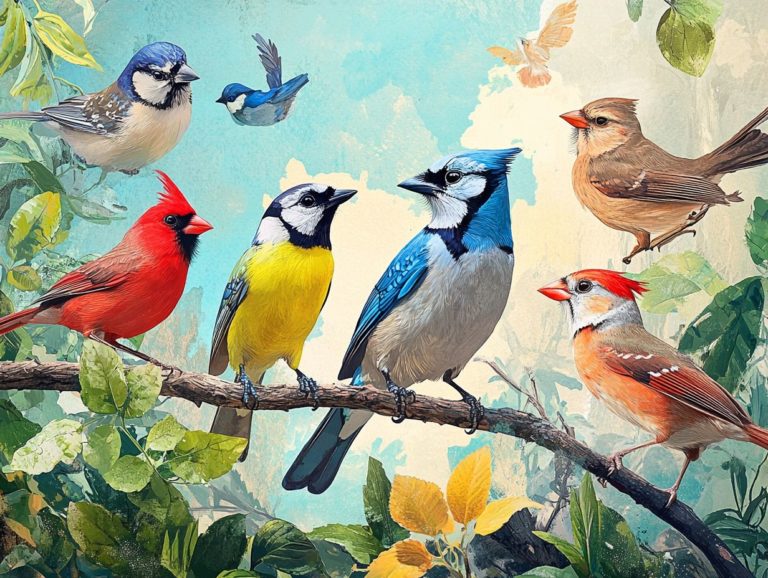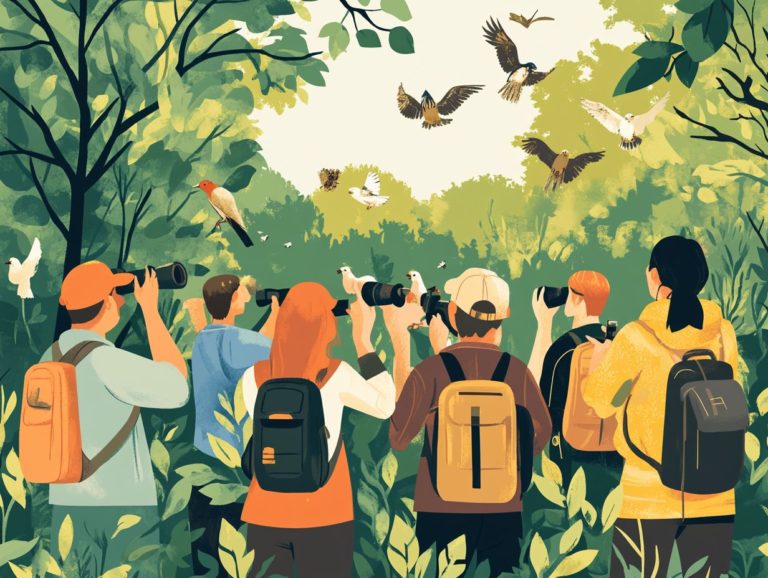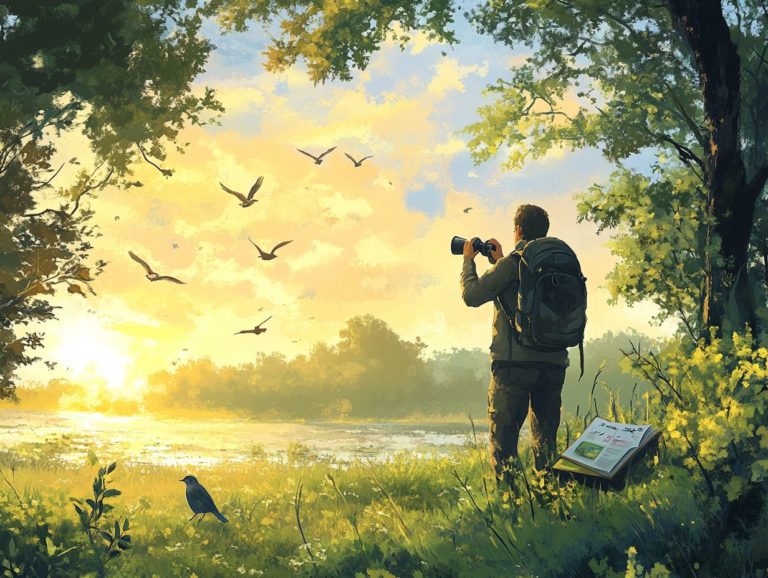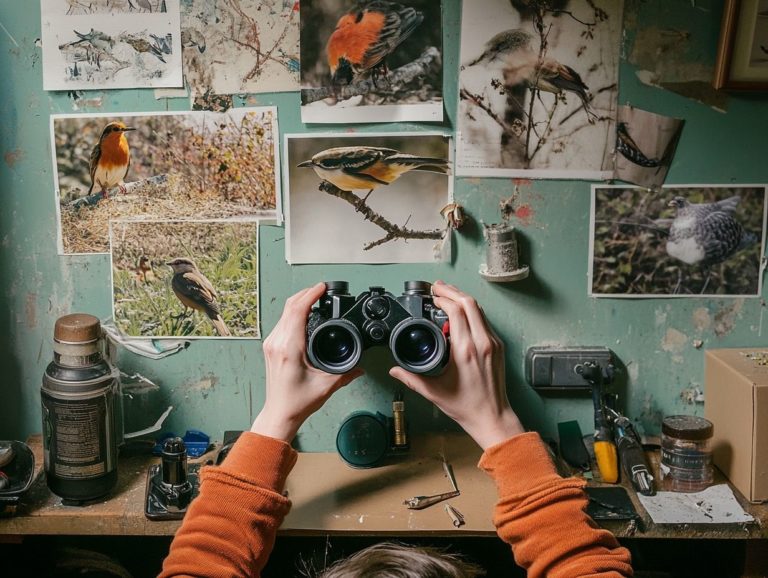What to Keep in Mind When Bird Watching Alone?
Birdwatching alone offers a mix of peace and excitement, allowing you to connect with nature at your own pace.
This article explores the many benefits of solo birdwatching. You can enjoy quiet moments in the wild and sharpen your observational skills with birdwatching tips. We ll discuss essential safety measures, gear recommendations, and practical advice to enhance your sightings.
It also covers proper etiquette to ensure a respectful experience for both wildlife and fellow enthusiasts. Whether you re an experienced birder or just starting out, there s valuable information for you.
Contents
- Key Takeaways:
- Benefits of Bird Watching Alone
- Safety Precautions for Bird Watching Alone
- Tips for a Successful Solo Bird Watching Trip
- Etiquette for Bird Watching Alone
- Frequently Asked Questions
- What to Keep in Mind When Bird Watching Alone?
- Is it safe to go bird watching alone?
- What are some safety tips for bird watching alone?
- What should I wear when bird watching alone?
- How can I stay organized when bird watching alone?
- Are there any legal restrictions for bird watching alone?
- What if I encounter a dangerous situation while bird watching alone?
Key Takeaways:
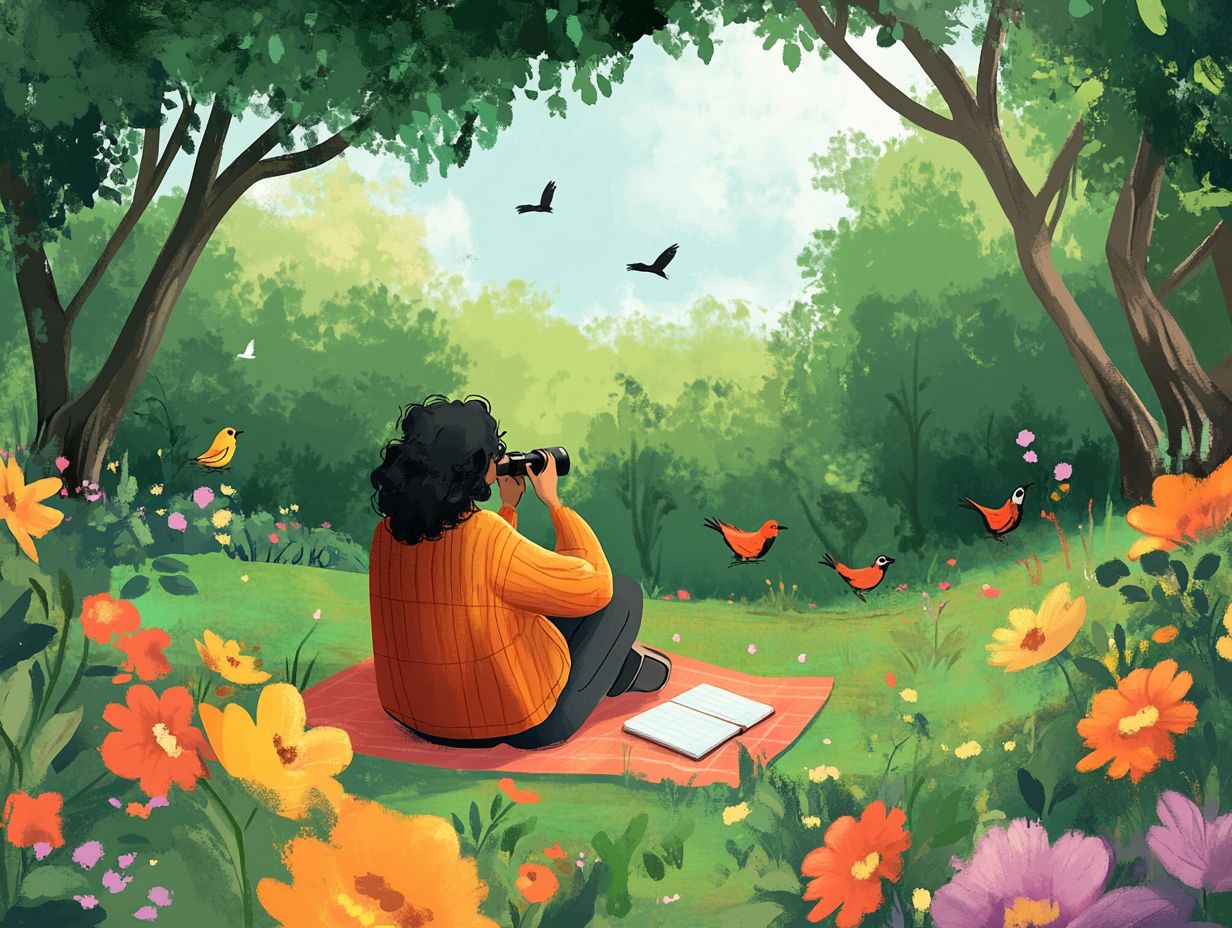
- Embrace the peace that comes with birdwatching alone.
- Stay safe by packing essential gear and informing someone of your plans.
- Enhance your experience by researching spots and being respectful to wildlife and fellow watchers.
What is Bird Watching Alone?
Birdwatching alone gives you a chance to fully immerse yourself in the natural world. You can build a deeper connection with your surroundings as you observe different bird species. While many enjoy the camaraderie found in birdwatching groups, solo birding offers a chance for personal reflection and self-discovery.
This practice can be calming and exhilarating. It encourages you to explore various habitats and use different birding techniques, from binoculars to field guides or apps like Merlin Bird ID.
The solitude of birding sharpens your awareness, making each flutter or song more meaningful. Spotting a bright cardinal, a majestic bald eagle, or rare Bewick swans becomes a personal victory, bringing a sense of achievement that often eludes group outings.
To improve your solo experience, using birdwatching tips and birding apps like eBird can be very helpful. These tools aid in identifying species while you track your sightings.
From the sweet song of a warbler to the busy flight of a woodpecker, as a solo birdwatcher, you develop a deeper connection with nature that supports mental well-being and a strong appreciation for wildlife, including diverse bird species.
Benefits of Bird Watching Alone
The advantages of birdwatching alone go beyond simple observation. They include personal growth, a strong connection with nature, and improved psychological well-being, which is especially beneficial for women and biracial women in outdoor settings.
Engaging in solo birding helps you cultivate a deeper appreciation for the natural world. It allows for a meditative experience that nurtures both peace and solitude, making it a perfect activity for those seeking introspective moments.
This practice lets you encounter various bird species at your own pace, free from group distractions. This results in a more enriching and fulfilling birdwatching experience.
Opportunities for Solitude and Connection with Nature
One of the greatest opportunities presented by bird watching alone is your chance to experience deep quiet and connect with nature on a deeper level. Solitary bird watching encourages you to slow down, tune into your surroundings, and appreciate the small interactions of wildlife within their ecosystem.
This solitude helps with bird identification using tools like a field guide, which helps you identify different bird species by providing pictures and descriptions. It also enhances your overall enjoyment of the outdoor experience, allowing for moments of reflection and inspiration in beautiful settings such as Colorado or Kansas.
When you explore the natural world without distractions, you cultivate a heightened awareness of subtle sounds and movements. Observing a flicker of a wing or the melodic notes of a rare songbird can awaken a sense of tranquility and connection.
These moments are further enriched by practical bird watching tips, such as maintaining a still posture and using binoculars to focus on distant flights. Over time, this mindful practice develops your understanding of local habitats, fostering an instinctive appreciation for the intricate relationships among species and their environments.
Safety Precautions for Bird Watching Alone

Always put safety first for a fun, worry-free adventure! When you embark on a solo bird watching expedition, it s crucial to prioritize safety precautions to ensure a delightful and risk-free experience in nature.
While bird watching alone can be an immensely rewarding adventure, it carries inherent risks that require thoughtful planning and preparation. By adhering to outdoor safety measures, you can dive in now to truly enjoy your bird watching journey while minimizing the potential dangers that come with hiking alone or exploring unfamiliar territories.
Essential Gear and Preparations
Having the right bird watching gear is essential for your solo bird watching adventure, ensuring both comfort and effectiveness in spotting a variety of birds. Key items to consider are high-quality binoculars, a reliable spotting scope, and a comprehensive field guide.
To truly enhance your joy of observing feathered friends, it’s highly advisable to invest in lightweight binoculars such as Celestron or Opticron with a solid magnification level typically around 8×42. A quality spotting scope can offer exceptional clarity when watching birds from a distance, making it easier to pick up on those subtle features that make each species unique.
A field guide specific to your region will be invaluable, allowing for quick reference and accurate identification. Incorporating savvy bird watching tips, like keeping a journal to track your sightings or using apps for on-the-go identification, can further elevate your experience.
These thoughtful choices in gear will not only make your trek more productive but also transform it into an exhilarating journey through the avian world, fostering a connection with wildlife and various bird species.
Tips for a Successful Solo Bird Watching Trip
To ensure a successful solo bird watching trip, it’s essential to embrace specific tips that will maximize both your sightings and enjoyment during this outdoor adventure.
Whether you re wandering alone through a local park or exploring the wilderness, grasping bird behavior, identifying the best times for viewing, and utilizing birding apps like National Geographic can significantly elevate your experience.
With the right strategies in hand, you ll be able to make the most of your solitary excursions while deepening your appreciation for the wonders of the natural world. Get your binoculars ready and step into nature for an unforgettable experience!
Maximizing Sightings and Enjoyment
Maximizing your sightings and enjoyment in bird watching requires a blend of patience, planning ahead, and a solid grasp of birding techniques. By employing effective strategies like scouting locations known for their diverse wildlife, utilizing camouflage in a place where you can hide while watching birds, and being mindful of the environment you can significantly enhance your chances of observing various bird species in their natural habitats.
Timing is essential. Dawn and dusk are often the most active periods for birds, making these prime times for your outings. Don’t overlook weather conditions; overcast skies can lead to increased bird activity, as birds tend to be less shy about hiding from the sun.
If you find yourself hiking alone, maintaining silence and exercising patience can lead to unexpected encounters with elusive species, such as the nightingale or turtle dove. A good pair of binoculars enhances your experience, providing clearer views of these magnificent creatures in their natural surroundings.
Etiquette for Bird Watching Alone
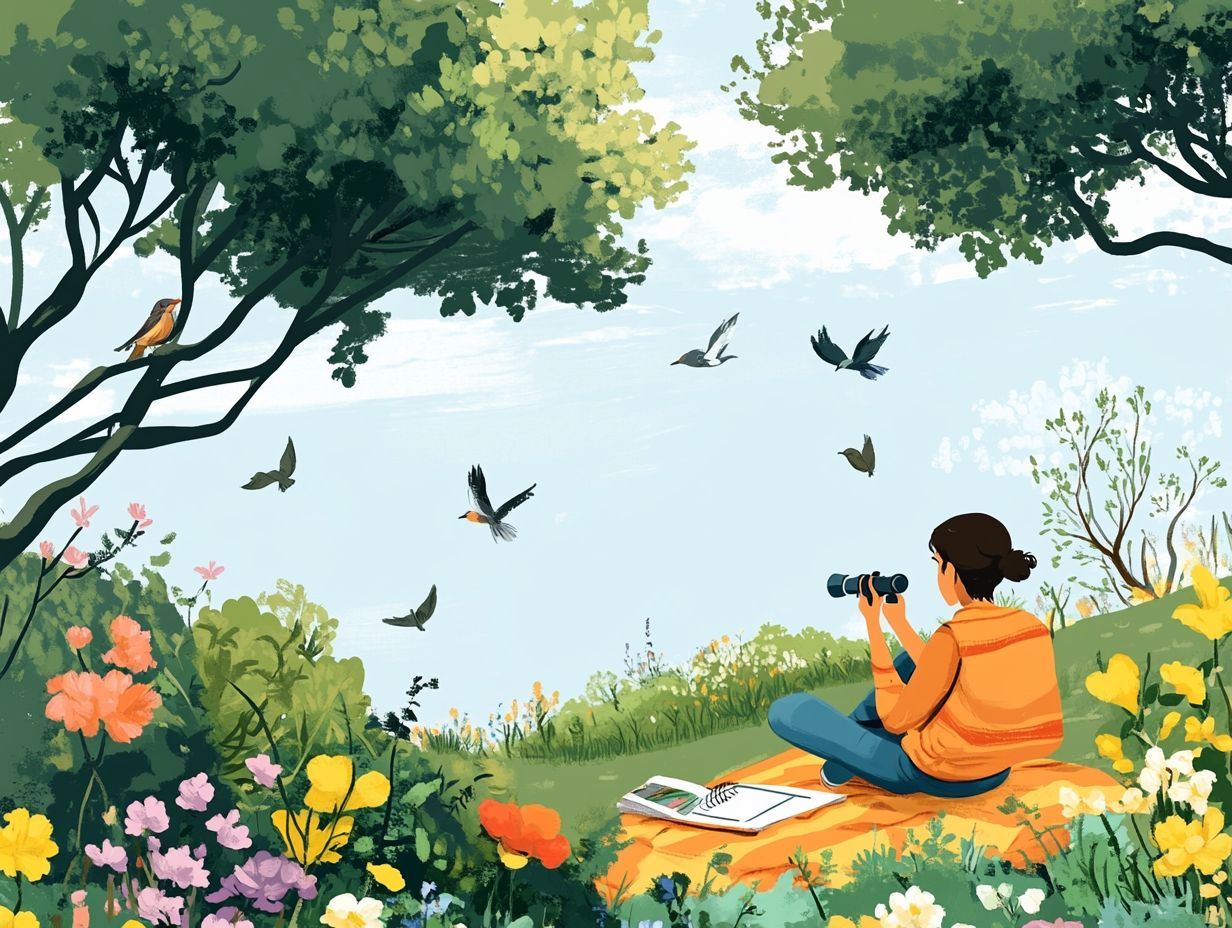
Practicing etiquette while bird watching alone is vital for your enjoyment and shows respect to wildlife and fellow bird watchers sharing the great outdoors.
Be mindful of your surroundings and the impact of your presence, especially when using binoculars or setting up a binocular blind. This approach elevates the experience for yourself and those around you. As a solo birder, it’s essential to adhere to guidelines that protect wildlife, such as avoiding disturbances to nesting sites. Ensure other enthusiasts feel at ease in their pursuits.
Respecting Wildlife and Fellow Bird Watchers
Respecting wildlife and fellow bird watchers is fundamental to enhancing your birding experience. By keeping a respectful distance from nesting sites and avoiding loud noises, you ensure that you don t disrupt the natural behaviors of the birds or intrude on the enjoyment of others nearby. This mindfulness creates a more harmonious relationship between you and the wildlife you observe.
To deepen this connection, familiarize yourself with specific guidelines designed to minimize your impact on avian habitats. Using binoculars instead of getting too close can significantly reduce stress on wildlife, allowing you to appreciate species like the Golden Eagle from a distance. Practicing outdoor safety like wearing muted colors and treading lightly can elevate your encounters while keeping both the birds and their surroundings unharmed, promoting a culture of respect and preservation.
By adhering to these principles, you enrich your birding experience and promote a culture of respect and preservation among all nature enthusiasts.
Frequently Asked Questions
What to Keep in Mind When Bird Watching Alone?
If you’re planning to bird watch alone, here are a few things to keep in mind, including what to look for in bird watching gear, for a safe and enjoyable experience.
Is it safe to go bird watching alone?

While it is generally safe to bird watch alone, it is always recommended to take certain precautions to ensure your safety.
What are some safety tips for bird watching alone?
Some safety tips to keep in mind when bird watching alone include informing someone of your location and expected return time, bringing a first aid kit and water, and being aware of your surroundings.
What should I wear when bird watching alone?
When bird watching alone, it is important to wear appropriate clothing and footwear for the weather and terrain. Long pants and closed-toe shoes are recommended, as well as a hat and sunscreen.
How can I stay organized when bird watching alone?
To stay organized when bird watching alone, consider bringing a journal or notebook to record your observations, as well as a map or field guide to help you identify different bird species.
Are there any legal restrictions for bird watching alone?
You must know any legal restrictions or permits needed for bird watching in certain areas.
Research the rules and follow them to enjoy bird watching without issues.
What if I encounter a dangerous situation while bird watching alone?
If you encounter a dangerous situation, stay calm and evaluate what s happening.
Call for help or move to a safe location if necessary.

